Suzanne Juel painting, the artist's sister-in-law and who would later become his third wife - Christoffer Wilhelm Eckersberg | Art print


View from behind

Frame (optional)
Art print Suzanne Juel, the artist's sister-in-law who would later become his third wife - Christoffer Wilhelm Eckersberg – Captivating introduction
The work of Christoffer Wilhelm Eckersberg, "Suzanne Juel, the artist's sister-in-law who would later become his third wife," presents itself as a poignant testament to intimacy and the complexity of human relationships. Danish painter of the 19th century, Eckersberg is often regarded as the father of Scandinavian realism, and this painting perfectly illustrates his innovative approach. By capturing the delicate beauty of Suzanne Juel, the artist manages to transcend a simple portrait to offer a reflection on love, beauty, and the passage of time. This emotionally charged painting invites the viewer to delve into the artist's personal universe while celebrating femininity in all its splendor.
Style and uniqueness of the work
The uniqueness of this piece lies in the finesse of the details and the mastery of light play that animates Suzanne's face. Eckersberg uses a palette of soft colors, blending warm tones and pastel shades, which create an atmosphere that is both intimate and dreamlike. Suzanne's pose, both natural and elegant, demonstrates a certain modernity for the time, moving away from the rigid conventions of academic portraits. The artist succeeds in capturing not only the physical appearance of his subject but also a deeper essence, a sensitivity that speaks to the soul. Every brushstroke seems imbued with palpable tenderness, making this work particularly touching and memorable.
The artist and his influence
Christoffer Wilhelm Eckersberg, an iconic figure of the neoclassical and then realist movement, marked his era with his innovative approach to painting. Trained at the Royal Danish Academy of Fine Arts in Copenhagen, he drew inspiration from European masters while developing a distinctive style that is uniquely his own. His influence on Danish art is undeniable, and he paved the way for a new generation of artists seeking to explore more personal and contemporary themes. Through his portraits, Eckersberg does not merely depict his subjects; he immortalizes them in a moment of grace

Matte finish

View from behind

Frame (optional)
Art print Suzanne Juel, the artist's sister-in-law who would later become his third wife - Christoffer Wilhelm Eckersberg – Captivating introduction
The work of Christoffer Wilhelm Eckersberg, "Suzanne Juel, the artist's sister-in-law who would later become his third wife," presents itself as a poignant testament to intimacy and the complexity of human relationships. Danish painter of the 19th century, Eckersberg is often regarded as the father of Scandinavian realism, and this painting perfectly illustrates his innovative approach. By capturing the delicate beauty of Suzanne Juel, the artist manages to transcend a simple portrait to offer a reflection on love, beauty, and the passage of time. This emotionally charged painting invites the viewer to delve into the artist's personal universe while celebrating femininity in all its splendor.
Style and uniqueness of the work
The uniqueness of this piece lies in the finesse of the details and the mastery of light play that animates Suzanne's face. Eckersberg uses a palette of soft colors, blending warm tones and pastel shades, which create an atmosphere that is both intimate and dreamlike. Suzanne's pose, both natural and elegant, demonstrates a certain modernity for the time, moving away from the rigid conventions of academic portraits. The artist succeeds in capturing not only the physical appearance of his subject but also a deeper essence, a sensitivity that speaks to the soul. Every brushstroke seems imbued with palpable tenderness, making this work particularly touching and memorable.
The artist and his influence
Christoffer Wilhelm Eckersberg, an iconic figure of the neoclassical and then realist movement, marked his era with his innovative approach to painting. Trained at the Royal Danish Academy of Fine Arts in Copenhagen, he drew inspiration from European masters while developing a distinctive style that is uniquely his own. His influence on Danish art is undeniable, and he paved the way for a new generation of artists seeking to explore more personal and contemporary themes. Through his portraits, Eckersberg does not merely depict his subjects; he immortalizes them in a moment of grace
12,34 €






